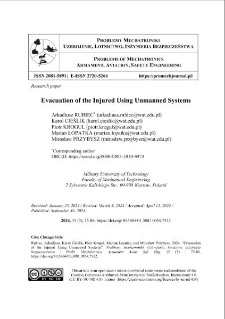Nasza Biblioteka Cyfrowa udostępnia 1 868 obiektów cyfrowych
Obiekt
Tytuł: Evacuation of the Injured Using Unmanned Systems ; Evacuation of the Injured Using Unmanned Systems
Tytuł odmienny:
Ewakuacja rannych z wykorzystaniem systemów bezzałogowych ; Ewakuacja rannych z wykorzystaniem systemów bezzałogowych
Współtwórca:
Karol CIEŚLIK, Piotr KROGUL, Marian ŁOPATKA, Mirosław PRZYBYSZ ; Karol CIEŚLIK, Piotr KROGUL, Marian ŁOPATKA, Mirosław PRZYBYSZ
Abstrakt:
This article explores the use of unmanned systems for evacuating wounded personnel from the battlefield. It focuses on conclusions drawn from conventional medical evacuation methods, particularly when wounded soldiers are still in the enemy’s operational zone, following the principles of Tactical Combat Casualty Care (TCCC). Then, general conditions of the injured were determined, which would require evacuation to a safe zone. This allowed us to define the critical capabilities needed for unmanned systems to perform these tasks. The ability of the unmanned system to pick up an injured person who is unconscious and unable to cooperate was identified as crucial. In the further part of the work, existing unmanned systems intended for rescue tasks were collected and critically analysed.
;
This article explores the use of unmanned systems for evacuating wounded personnel from the battlefield. It focuses on conclusions drawn from conventional medical evacuation methods, particularly when wounded soldiers are still in the enemy’s operational zone, following the principles of Tactical Combat Casualty Care (TCCC). Then, general conditions of the injured were determined, which would require evacuation to a safe zone. This allowed us to define the critical capabilities needed for unmanned systems to perform these tasks. The ability of the unmanned system to pick up an injured person who is unconscious and unable to cooperate was identified as crucial. In the further part of the work, existing unmanned systems intended for rescue tasks were collected and critically analysed.
Miejsce wydania:
Warszawa
;
Warszawa
Wydawca:
Wojskowa Akademia Techniczna ; Wojskowa Akademia Techniczna
Data utworzenia:
Data złożenia:
Data akceptacji:
Data wydania:
Rozmiar:
Identyfikator:
oai:ribes-88.man.poznan.pl:2713
Sygnatura:
doi:10.5604/01.3001.0054.7512 ; doi:10.5604/01.3001.0054.7512
ISSN elektroniczny:
ISSN drukowany:
Język:
Licencja:
kliknij tutaj, żeby przejść ; kliknij tutaj, żeby przejść
Właściciel praw:
Wojskowa Akademia Techniczna ; Wojskowa Akademia Techniczna
Strona początkowa:
Strona końcowa:
Tom:
Czasopismo:
Słowa kluczowe:
mechanical engineering, unmanned ground vehicles, evacuation of the injured, mobile robots ; mechanical engineering, unmanned ground vehicles, evacuation of the injured, mobile robots
Kolekcje, do których przypisany jest obiekt:
Data ostatniej modyfikacji:
16 paź 2025
Data dodania obiektu:
16 paź 2025
Liczba wyświetleń treści obiektu:
0
Wszystkie dostępne wersje tego obiektu:
https://ribes-88.man.poznan.pl/publication/3050
Wyświetl opis w formacie RDF:
Wyświetl opis w formacie OAI-PMH:
| Nazwa wydania | Data |
|---|---|
| Evacuation of the Injured Using Unmanned System | 16 paź 2025 |

